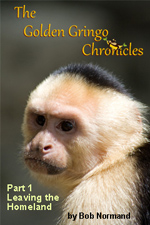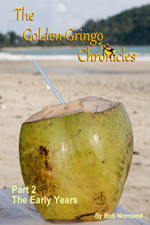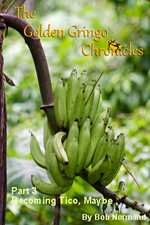A GG Selfie
 |
Publisher's Corner
If you would like to read a version of
the Golden Gringo Chronicles
in a narrative format,
as a hard-copy novel
or an e-book
check it out HERE
JUST RELEASED! Mariposa, A Love Story of Costa Rica JUST RELEASED!
NOW AVAILABLE ON AMAZON.COM!
 Five hundred years before the Spanish found the American
continent, around the end of the first millennium, Native Americans lived and prospered in Central America, including the land now known as Costa Rica. Truly a natural wonderland then and now, the natives were able to employ their farming skills and prosper from the rich soils, the forests filled with game, herbs, and spices, and the lakes and two oceans rich with fish and crustaceans.
Five hundred years before the Spanish found the American
continent, around the end of the first millennium, Native Americans lived and prospered in Central America, including the land now known as Costa Rica. Truly a natural wonderland then and now, the natives were able to employ their farming skills and prosper from the rich soils, the forests filled with game, herbs, and spices, and the lakes and two oceans rich with fish and crustaceans.
Mariposa, or butterfly, is a story about two young Native Americans, each a favored child of a chief, but of different tribes. These two tribes, historically hostile to each other, lived a few days march apart in the mountains north and east of Costa Rica’s central valley.
The two natives meet by accident, fall in love and begin to plan a life together only to be frustrated by events beyond their control. The lovers are eventually drawn to a mountain volcano which is thought by many to be the home of the gods, particularly Sib'ö, the Great Spirit, who they believe had created the world.
The story as written incorporates the classic ending of Costa Rica's Legend of Zurqui, one that reflects the beauty, mystery and spirituality that is Costa Rica.
Preview the Book on Amazon.com at: Mariposa Preview
(This is Chapter 1 in its entirety)
ORDER IT HERE ($7.95): Mariposa on Amazon.com (Kindle Version Available - $4.99)
Broken News
(All the News That's Fit to Reprint)
Cubans Out - Africans (and Haitians) In
The Chronicles has been following the recent plight of some 8,000 Cuban emigres who ended up in Costa Rica trying to get to the Mexican border with the U.S. The objective? Once there, to walk across into the U.S. with dry feet.
They hoped to take advantage of an old 1960's U.S. government rule designed to make one important exception to the immigration rules during the period when Cuba went communist. The policy was called the "wet foot-dry foot" rule which basically meant that, despite U.S. Coast Guard patrols that turned back boats to Cuba, if a Cuban could make it to shore he was in. More recently, somebody, probably the illegal "coyotes" that took the emigres money and promised them safe passage, got the bright idea that they didn't need to get their feet wet; just get to the Mexican/U.S. border and walk across, galoshes or not.
The only fly in the salsa was the fact that Nicaragua shut its borders tight and wouldn't let the Cubans pass through to the north. Eventually Costa Rica accommodated them in style and flew them up to Mexico where, evidently, the plan worked. Little more was heard from or about them, with the exception that a few hundred decided to remain in Costa Rica permanently rather than continue their difficult diaspora.
"Africans" at Peñas Blancas
 |
Since this emigration plan worked so well, other groups are now trying to replicate it, among them some 2,000 who claim to be Africans. They've taken up position at the Peñas Blancas border crossing into Nicaragua (obviously, Costa Rica let them pass through the southern border at Paso Canoas once more). The Nicaraguan border still remains shut to such emigres but some have been successful at walking through that country with the always available help of the coyote guides (at $1,200 to $2,000 per person). But most of them can't afford the coyotes and are still hung up at Peñas Blancas.
Some of the Africans claim they are coming up from their original emigre destination, Brazil or Columbia where they had gone a few years ago to escape dire economics in their homeland and enjoy much more favorable prospects in Latin America. But now those latin american economies that they had settled in have been retrenching, like in Brazil, for the past couple of years.
Interviews by government workers and local press have determined however that the mix of people's origin is quite different than that stated by the emigres themselves. Perhaps as high as 50% have Haitian accents or speak Spanish with a Dominican Republic accent, the country bordering Haiti. An additional 10% come from Pakistan and Afghanistan. These latter reported they chose this route after Europe cracked down on its borders.
Stay tuned, no doubt more is to be news worthy and revealed.
Ticoland Über Alles
Sometimes it seems it would be simpler if the Costa Rican government just declared a full week each year that would be devoted to strikes (huelgas) to get the bad attitude out of the systems of the various complainers. The week of August 8 which just passed was such a week.
Perhaps we should establish a new annual festival and call it HuelgaWeek, similar to Guanacaste Week.
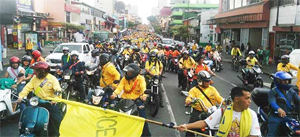 This year it began with a huelga on Monday the 8th, by the labor union representing the folks at ICE, the Instituto Costarricense de Electricidad, the power company. Often dressed colorfully (bright yellow is their trademark) , the march through town was rather uneventful, other than tying up traffic considerably in and about San José.
This year it began with a huelga on Monday the 8th, by the labor union representing the folks at ICE, the Instituto Costarricense de Electricidad, the power company. Often dressed colorfully (bright yellow is their trademark) , the march through town was rather uneventful, other than tying up traffic considerably in and about San José.
The primary disgruntlement of the electrical/telecom workers is that they need to be paid more and that the administration of the Instituto, which is government owned and operated, should be replaced (I presume they want this latter action so the workers could be paid more). The ICE main office released a statement saying only 11 of their 135 public offices had been closed due to absenteeism. 135 offices? Really? And that doesn't include payment centers all over Costa Rica. You can pay your electric bill at most pharmacies and many "Pay Here" locations.
Taxi Drivers Being "Detained"
 |
On Tuesday the 9th it was the taxistas turn to huelgarize. The taxi people are more practiced and efficient at this kind of thing and know how to use their vehicles more efficiently to snarl traffic big time. In this case that included blockading the principal international airport in Alejuela for a few hours.
They also tend to be more militant. Their major bitch this huelga was about Uber, that nasty upstart taxi company that's raising havoc in many a country by offering cheaper personal taxi-like service (I walk the gray line of diplomacy here) in newer, more comfortable cars.
The taxistas want the government to ban Uber or at least make them follow the same licensing and taxing regulationsas the regular (red) taxis, But Uber sees themselves as an association of private drivers tied together only by a smart phone app. So far the government has declined to ban them, citing the employment they provide. That seems to me to be a weak argument and my suspicious mind quickly wanders to thinking of untraceable shenanigans that involve money changing hands on high.
The taxi strike was not as peaceful as the one the electric boys had. One officer suffered three teeth knocked out and several taxi drivers complained of rough treatment. Thirty three (33) taxis were confiscated and will be ransonable for quite a large fine. Over one hundred traffic tickets were handed out and 74 persons were "detained" (that's Costa Rican Spanish for arrested) - see photo above, left. Four of the arrested face felony charges, particularly the ones that punched out the cop.
On Wednesday of HuelgaWeek another strike was planned, This time it was the division of the public employees union that makes up the Transito Police, the police responsible for traffic control and highway safety. Their main complaint was that many of their vehicle patrols are manned by only one officer. Before the strike could come off, the group suffered the tragic loss of one of their officers who was shot while on patrol alone. On Taxista Tuesday the Ministerio of Obras Publicas and Transportes (MOPT) met with the police union and agreed to the doubling of officers on patrol, thereby averting the Wednesday strike.
Gastronomia Chepeño (See What's-in-a-Word below for the significance of "Chepeño")
There are lots of fine restaurants in Costa Rica but there are no really excellent non-latino ethnic restaurants, right? Wrong.
My good friend, Michael Miller, is the author of "The Real San Jose" which is, in my opinion, the best English guide to our capital city. Michael is at his best when describing out-of-the-way areas in San José that tourists are unlikely to know or find. He has just written an article on international restaurants in San José entitled: "Enjoying Downtown San José's International Restaurants". In the article are selections including Greek/Turkish, Italian, Chinese, German and Argentine (yeah, I know, Argentina is Latino, but if you've ever had a steak in Buenos Aires, you know that, at least for beef, it's a different world and cuisine).
Barrio Escalante (Partial Map)
 |
When GG read about the place with all the lamb dishes (Sofia Mediterraneo) he felt compelled to call Michael and arrange a dinner with him on my next visit to San José, which occurred August 18. The area where we ended up is called Barrio Escalante and is a four to five block zone that runs along Calle 33 between Avenida Tres and Avenida Siete. For those of you inclined to read maps, that's about 15 blocks east of the Teatro Nacional and about 3-4 blocks north of Avenido Segundo. For those of you not so inclined, it's a short ten minute taxi ride from the Teatro.
The partial area map to the right (only about half the street) includes a couple of dozen restaurants ranging from pizzerias to full dining ethnic-oriented places like the Sofia (indicated by an X on the map right). It's also an area with several micro-breweries for those who like to sample new and specialty beers.
The results of our "study" of the Sofia are given below in the ROMEO section.
Quepos Quickies
Whoa! (Angler Michaels on Left)
 |
Getting Snookered. Where does a Florida fishing guide go when he wants to catch the big snook? Well, Costa Rica, of course. Just ask Orlando guide Ward Michaels.
Of course, it helps to know what you're doing. A many-times visitor to Costa Rica over the years and on close terms with local guides, Michaels just had his best time ever getting snookered. He..."planned the trip to coincide with spawning season and a new moon cycle. Female snook would be heavy with eggs, and they’d be feeding aggressively in daylight hours, after the dark of the new moon nights." Yeah, of course, GG knew that.
Check out the photo of Michaels, the snook and his guide above, right. The result was the taking of a 60 lb snook that is likely to become the current world record for this type of fish once the IGFA (International Game Fish Association) sanctions the catch, that is. They seem to require more paperwork and verification than a realty transfer in Costa Rica. If it is verified, it will usurp the title currently held by the catch of another Quepos angler, a 57-pound, 12-ounce black snook caught at the mouth of the Rio Naranjo in August 1991.
Michaels and his friends trolled sardines at a 30 foot depth over a sand bar and, in addition to Big Snookey, they hauled in several in the 30 lb class and four over 40 lbs including 47 and 50 pounders. Now that's a lot of dedos de pescados (fish fingers) amigos, not to speak of the tartar sauce requirement.
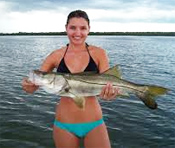 GG's first encounter with a snook was on a plate in a restaurant in Sarasota when I moved there in 1998. It was grilled medium-firm white flesh that was served with a lemon butter sauce. Yummers!
GG's first encounter with a snook was on a plate in a restaurant in Sarasota when I moved there in 1998. It was grilled medium-firm white flesh that was served with a lemon butter sauce. Yummers!
I also remember that there were quite a few docks on the ICW (Intra-Coastal Waterway) behind Siesta Key that kept a light bulb burning at the end of their dock to attract snook at night, making them easier to catch. From the ones that I saw there, the snook pictured with the young lady to the left was above average (but then, so is she). Michaels might consider as suitable for a quick lunch.
Congratulations Ward, my guess is it will be a long time before that record is beaten; but then again, there's always next year, right amigo?
 Fitting In. Some time ago GG came across an interesting Spanish verb. The verb "caber" means "to fit" or "to fit in". It just so happens that the first person singular for caber, i.e., if you were to say " I fit in", is "quepo" (there go those sneaky Spanish dudes changing verb stems again).
Fitting In. Some time ago GG came across an interesting Spanish verb. The verb "caber" means "to fit" or "to fit in". It just so happens that the first person singular for caber, i.e., if you were to say " I fit in", is "quepo" (there go those sneaky Spanish dudes changing verb stems again).
It hit me that GG has come to fit into Quepos quite well so I had a t-shirt made up that says "Quepo en Quepos". The saying has a nice double entendre feel to it, don't ya think?
I'm starting a campaign to make it the official motto ("la lema") of the Canton and Municipalidad of Quepos.
TOP
Rumble Talk
(Shaky Happenings On or About the Pacific Rim)
In Costa Rica. Sshhhhhhhhhhhhhhhhhhhhhhhhhhhhhhh!
It's been relatively quiet for the last month, only three to four ice-cube rattlers but nothing to get excited or nervous about.
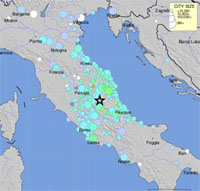 Off the Rim of Fire. The main action in August was not on the Pacific Rim but instead in central Italy where a 6.2 quake hit in the Apennine mountains. Much like Costa Rica, Italy has a mountainous ridge running down its spine from north to south and the plates that formed these mountains continue to slip at an unpredictable pace.
Off the Rim of Fire. The main action in August was not on the Pacific Rim but instead in central Italy where a 6.2 quake hit in the Apennine mountains. Much like Costa Rica, Italy has a mountainous ridge running down its spine from north to south and the plates that formed these mountains continue to slip at an unpredictable pace.
The epicenter was near a town called Norcia about 90 miles (150 km) northeast of Rome and was strongly felt in the capital city. The terremoto hit around 3:30 AM in the middle of the night catching people in bed. Although 6.2 on the Richter scale is not extremely high, the depth of the center was only 10 km, quite shallow. Damage was extensive and fatalities quickly mounted in the residential areas and exceeded 250 by the end of the second day as more and more bodies were extracted from the rubble.
On the way to the bus station the next morning I happened to pass buy the local Italian bakery in Quepos named La Panaderia. The owner and his wife were outside and I asked them if they knew the town where the earthquake had hit. "I grew up 10 km from that town", says he. I asked if their families had encountered any problems but he said no. Small world, eh?
A friend passed on a website reference that shows you the before and after pictures of this disaster just by moving your cursor across the picture: go here: Italian Earthquake. (Thanks Mike). Take a look at it, frightening and fascinating.
Check Out Recent Earthquakes Around the World
Posted by the U.S. Geodetic Survey: Today's Quakes |
Search the Golden Gringo Chronicles Archives for Topics That Interest You
You can use our Archives to explore almost 200 feature articles of the Golden Gringo Chronicles plus find Broken News items and ROMEO restaurant reviews. Enter your topic or item to search in the Google Search Routine below and follow the links offered from the search results. Suggestion: Enter only a simple, precise and unique as possible keyword or two in order to narrow the number of references retrieved:
Golden Gringo Chronicles - Enter Search Here
Readers: Send comments, suggestions, ideas, meaningless statements and
jocular observations concerning the Chronicles to GG here: gg@goldengringo.com
¿Que Es Eso? Department
(What is This?)

What do you think these are?
If you think they're furry Toy Chests, you're only partially right.
Answer in What's-in-a-Word section below.
Raising the Roof
(and Scraping the Tropical Sky)
View of Downtown San José from the West (Hospital Mexico - Right - GG's Favorite Place to Get Cataract Surgery)
 |
When cities grow large, the economics of land acquisition and construction pressure a change in strategy from continuing the sprawl outward to building upward. San José, Costa Rica has been moving that way in the last few years and recent project announcements indicate that the pace of that type of development is now accelerating.
Torres Paseo Colon
 |
The current holder of the height record for a building in San José is the dual tower Torres Paseo Colón building (right), less than a kilometer east of the city's large La Sabana park.
These towers come in at 29 or 30 stories, depending on whose counting. They are largely an apartment and condo complex with some office and commercial space. Quite a big project but a lot more is coming, some of which will be in Torres Paseo Colon's neighborhood.
Let's start with the several residential buildings of 19 to 25 story heights that are either on the drawing board or already under construction. Similar to the Torres, these new buildings will add hundreds more apartments in different sections of the city including Heredia and Curridabat.
But the future is better indicated by two projects to be located near the center of the city, one on Paseo Colón east of Parque La Sabana, near Torres Paseo Colon and one on the north side of La Sabana near the current ICE headquarters. To the uninitiated, ICE is not frozen water nor a field office of U.S. Immigration; it's the building that houses the Instituto Costarricense de Electricidad - the electric company, the workers of which conducted the strike mentioned above.
Cosmopolitan Tower
Artist's Rendition
 |
Torre 40
 |
The Paseo Colón project will be a 40 story tower called, appropriately, Torre 40 (make that 40 stories above ground but add twelve more stories below ground, for a total of 52). The building will be situated next to the Mercedes "Tower" (this old landmark, now rapidly becoming a relic, has fifteen floors including three underground). Next to it, Torre 40 (artist's rendition right) is planned as an office building and expected to open in 2019 and will then become the tallest building in Costa Rica.
But Torre 40's new height record will not be a record very long.
The second skyscraper project will be called the Cosmopolitan Tower to be located next to the ICE building on La Sabana Norte, the north side of the city's La Sabana Park (clever naming , eh?). This building will be primarily apartments and condos, when it is opened, which will be sometime after Torre 40. Then it will become the tallest building in Costa Rica at 42 stories above ground (don't know how many below).
These two rascacielos (see What's-in-a-Word below for that meaning) will bring a significant change to San José's skyline and will be, at least for the moment, the tallest buildings in all the six countries of Central America, with one important exception. That is so because nothing in Honduras, El Salvador, Nicaragua or Belize exceeds thirty floors at the moment.
The one Central American exception in the race for height is Panama. Panama City has undergone a tremendous growth in tall buildings over the last three decades and can boast over a dozen buildings that exceed 60 floors and two over 70 floors. Below is a view of the current Panama City:
Panama City Skyline Taken From an Area Near the Canal Zone

|
The tallest building in Panama City currently is the Arts and Yoo Tower that stretches 78 floors above the ground (photo lower, left). Oh it's just another apartment building with almost unlimited luxury features (that means bring lots of the local currency, $U.S., to buy or rent).
Trump Ocean Club Panama
 |
Arts and Yoo Tower
 |
I made the mistake of wondering what "Yoo" was and came up with this from its website: "YOO is a residential and hotel design company offering the creative visions of world renowned designers Philippe Starck, Marcel Wanders, Jade Jagger, Kelly Hoppen, Steve Leung and the YOO Studio. With 82 projects in 57 cities and 34 countries, throughout Asia, Africa, Australia, Europe, North and South America and the Middle East, YOO is a thoroughly international lifestyle brand."
Wow, sorry I asked. Same to Yoo too.
Another Panama City rascacielos, coming in at the paltry height of only 66 floors, but with a rather kool design that looks somewhat like a football, is the Trump Ocean Club Panama (photo above).
World Trade Center, Old and New
 |
 |
All of this brought to mind the 1970's when the United States indisputably held the world record for tallest building in the world with the construction of the World Trade Center in New York (1973). The"Twin Towers", as they came to be known, included a restaurant and lounge 110 stories above Manhattan. GG had the pleasure of visiting there two times during the 1970's and once again in the '90's.
There was something spectacular about sitting comfortably at 1,700+ feet (110 stories) in a tower with an incredible view and sipping a Manhattan in Manhattan (♫ "those were the days my friend, I thought they'd never end..."♫), You could look down on the planes coming up the East River making their approach to La Guardia.
It was heartbreaking to watch the towers come down on September 11, 2001, only twenty eight years after their inauguration. A new single replacement tower (above, right) has been constructed and was officially inaugurated on November 3, 2014. It is 104 stories and will eventually be surrounded by a number of other skyscrapers like the old one was, creating a whole new commercial district of skyscrapers.
Burj Khalifa Tower Dubai, 160 Stories
 |
There was something else I found interesting about the old WTC. The tubular design of the building gave it a good deal of "flex" and it was reported that, in a strong wind, the top of the towers could sway off center by as much as 13 feet. I remember that the men's lavatory walls were finished in large Italian, red marble plates and, when the building began to sway, the edges of the plates rubbed against each other creating a unique and eerie squeaking sound. Kool.
Since the old WTC, at least three other rascacieloss have been built around the world, primarily in Asia and the Middle East, that have exceeded the 110 floor record. The current world record is a building called the Burj Khalifa Tower located in Dubai, United Arab Emirates (photo left) that is a full 160 stories high. That's almost 50% taller than the old World Trade Center. The observation deck is on the 124th floor and the world's largest shopping mall is at the base. Zowie, look what oil money hath wrought!
The old WTC had the largest and most powerful elevators I have ever experienced. My memory wants to say they each could hold 30 people comfortably, but be advised that my memory these days is often wanting. Those elevators in express mode took a full two minutes to get to the top.
I wonder what kind of elevators the Burj Khalifa has? Sectional elevators perhaps? Anti-Gravity? Rockets?
¡Solo Bueno!
TOP
On Being a Catador
(How Sweet It Is, or Isn't)
In Costa Rica we take our coffee seriously. We have to because of the availability of so many different quality brands grown in the foothills of our mountains demand our fair attention and enjoyment.
 After living here a couple of years and then returning to the States, I once sipped a cup of java at a restaurant in Florida and almost lost my breadth. Where was the deep, rich flavor I had become used to? Not in this restaurant obviously. After sampling a number of places during that visit, I came to the conclusion, surprisingly and reluctantly, that the best coffee in that town was to be found at Starbucks. Really? Then I learned that Starbucks gets a fair portion of its beans from contract farms in Costa Rica. Fancy that.
After living here a couple of years and then returning to the States, I once sipped a cup of java at a restaurant in Florida and almost lost my breadth. Where was the deep, rich flavor I had become used to? Not in this restaurant obviously. After sampling a number of places during that visit, I came to the conclusion, surprisingly and reluctantly, that the best coffee in that town was to be found at Starbucks. Really? Then I learned that Starbucks gets a fair portion of its beans from contract farms in Costa Rica. Fancy that.
Chorreodor
 |
Coffee plants come in two varieties, arabica and robusta. The latter is considered to produce inferior tasting beans and for that reason, only arabica is allowed to be grown in Costa Rica by law (it's kind of the French Champagne thing where the French government only approves of champagne that is grown in Champagne country). Still, much like wine, the same specie of coffee plant can produce different tastes because of local soil and weather conditions.
Venture into many homes in Costa Rica and you are likely to see a device that allows for the drip brewing of a single cup of coffee. The chorreodor (right) may look like a place to hang an old sock but it makes beautiful coffee - it's a coffee lover's thing.
Catadores, or coffee tasters, are as important in Costa Rica as wine tasters are in France. Catadores train for five years to learn exactly how to slurp the coffee from a spoon onto their taste buds. They taste it cold—a good coffee should taste just as good whether it is cold or hot. My guess is it's also easier to distinguish sources of the coffees sans the heat. And yes, there are national champions that compete from countries all over the world. At the last world tournament there were 33 countries represented in the competition, a meet that is held annually in different parts of the world, like the world cup of futbol or the Olympics.
 Here's how the competition works: "Three cups are placed in a triangle, with 2 cups being identical coffees and one cup being a different coffee. Using skills of smell, taste, attention and experience, the cupper will identify the odd cup in the triangle as quickly as they can. A total of 8 triangles are placed in each round. The top 8 competitors with the most correct answers and the fastest time proceed to the Semi-Finals round. Then the top 4 will compete again in the Finals round to determine the next World Cup Tasters Champion."
Here's how the competition works: "Three cups are placed in a triangle, with 2 cups being identical coffees and one cup being a different coffee. Using skills of smell, taste, attention and experience, the cupper will identify the odd cup in the triangle as quickly as they can. A total of 8 triangles are placed in each round. The top 8 competitors with the most correct answers and the fastest time proceed to the Semi-Finals round. Then the top 4 will compete again in the Finals round to determine the next World Cup Tasters Champion."
Céspedes in 2015 Competition
 |
In Costa Rica we have a young man named Juan Gabriel Céspedes (right) who is renowned for his coffee tasting abilities and has been the Costa Rican national champion for the last four years. Gabby takes his tasting seriously and evidently has a remarkable set of taste buds, so much so that it won him the World Championship in 2015 in Gothenburg, Sweden.
As if that wasn't enough, Gabby, in the 2016 world competition held in Shanghai, China from March 29 to April 1, won the world title again. He became the Bicampeón, that is the world champ for two years in a row (bicampeón is a particularly Spanish word that doesn't relate well in English - at first I thought they were referring to his linguistic ability or sexual orientation).
Bicampeón Céspedes
 |
To get his title, Céspedes went through a preliminary round, a quarter final, a semifinal and a final competition and had to defeat (bad word, better is... be faster and more accurate) than national champions from 33 countries. In the final phase, Céspedes won six of eight hits in 7.41 minutes. Runners up were Dongho Lee of Korea, five in 7.50, Mateusz Petlinski of Germany four in 4.12 and Boris Ortner of Austria with three in 4.27 minutes. The Tico dude is not only quick but he's better able to discriminate between brews.
So amigos, it's not just about scooping some Chase & Sanborn into a percolator. It's about growing the right kind of beans in a naturally rich soil, using pruning and farming techniques that encourage healthy plant growth, carefully selecting the beans when they're perfectly ripe, using proper drying and storage techniques and employing careful roasting processes that retain the most flavor. It's then that you have a great coffee.
I feel privileged to live in an area where I can sample the best, even if I don't have the distinguishing taste buds of a Gabby Céspedes.
¡Solo Bueno!
TOP
Las Mariposas
(The Butterflies of Costa Rica)
"I do not know whether I was a man dreaming I was a butterfly,
or whether I am now a butterfly dreaming I was a man."
-Chuang Tse (4th Century BC Chinese Philosopher) |
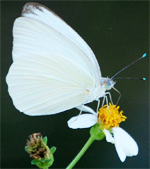 Take a short walk into almost any green area of Costa Rica (if it's the jungle, do so only with a guide) and you will most likely be set upon by a number of mariposas (butterflies) happily fluttering around you. The number and types of butterflies here are truly staggering; they are prolific and nearly omnipresent.
Take a short walk into almost any green area of Costa Rica (if it's the jungle, do so only with a guide) and you will most likely be set upon by a number of mariposas (butterflies) happily fluttering around you. The number and types of butterflies here are truly staggering; they are prolific and nearly omnipresent.
Just as a minor example, I got up to get a soda while writing this article and glanced out my kitchen window to see two solid white butterflies playing tag across the roof of my landlord's garage. And Quepos is not exactly the jungle, not even country, just a town and I live downtown. Those two happy flutterers were probably just a couple of Appias Drusillas shown in the photo to the left. (Sounds like I'm smart, eh? Naw, I admit it, I just looked it up)
 The butterflies of Costa Rica are a good example of the country's reputation as a place of incredible biodiversity. We are home to around 6% of all the world's biodiversity as measured by the number of known amphibian, bird, mammal, reptile, and vascular plant species. It's crammed into a relatively small land area that amounts to only 0.01% of the world total. In my arithmetic that's an imbalance of 600 to 1. Or you can just look at it as an extremely dense and rich wildlife area.
The butterflies of Costa Rica are a good example of the country's reputation as a place of incredible biodiversity. We are home to around 6% of all the world's biodiversity as measured by the number of known amphibian, bird, mammal, reptile, and vascular plant species. It's crammed into a relatively small land area that amounts to only 0.01% of the world total. In my arithmetic that's an imbalance of 600 to 1. Or you can just look at it as an extremely dense and rich wildlife area.
Total species wise, Costa Rica comes in at number 15 in the world with 13,630 "amphibian, bird, mammal, reptile, and vascular plant species". Brazil is number one with 59,851 species, including the incredibly rich amazon region. That's 4.4 times the species in Costa Rica but the land area of Brazil is 167 times the size of Costa Rica. Just for comparison, the U.S., which comes in at number 9 in diversity, has 21,474 species, or 58% more than Costa Rica but the land area ratio is 193-U.S. to 1-CR.
Banded Purple Wing
 |
Nuff said about biodiversity, except that the above doesn't include insects and a butterfly is actually a six-legged, winged insect. With regard to butterflies alone, it is estimated that in Costa Rica there are about 18% of all the butterfly species in the world, a diversity ratio even more exaggerated than the species mentioned above. Almost 1,500 species of mariposas have been identified in Costa Rica (that's just one of the fifteen hundred species of butterfly shown to the left) and there are as many as 8,000 more in the moth variety. With a total of 9,500 species of moths and butterflies, there's a lot of fluttering going on here.
Sometime in the future we'll give the moths their due in a separate article, but let's first review the difference between a butterfly and a moth. According to one source: "Butterflies are active during the day, moths at night. As a result, they have different lifestyles and adaptations. Butterflies close their wings when they rest; moths open them. A butterfly antenna is knobbed or club-shaped; moth's are various shapes (not usually clubbed). A butterfly's body is long, slender, not hairy; a moth's is short, stout, and usually hairy (sounds like some of my relatives - Ed.). Moths can be destructive (some of my relatives can also - Ed.).
Western Pygmy Blue
 |
Back to the butterflies. The smallest butterfly here is probably the Western Pygmy Blue (photo right), which is indigenous to much of the Americas. It has a wingspan of only one and a quarter centimeters or about a half inch. Much of this little fellah is not blue as can be seen from the photo but it's called that because it falls into a specie family that includes most of the blues.
 |
Single Owl Butterfly |
 |
Pair of Owl Butterflies
(Get a Room Amigos) |
The current record holder for the largest butterfly in Costa Rica is the Owl Butterfly shown in the two photos to the left. It can reach up to 20 centimeters (8 inches) in wingspan (some butterflies in other parts of the world can reach 30 cm). You can surmise from these pics just how the Owl got it's name, particularly from the single one on top that has its wings flared.
Glasswing
 |
One other unusual specie that must be mentioned forthwith is the Glasswing (photo right). Aptly named, you can look right through its transparent wings. Another honorable mention for Costa Rica goes to the Blue Morpho, one of the most beautiful and prolific mariposas here but we'll discuss this beauty more fully below.
The color seen on a butterfly's wings does not come from pigment. It is a reflection from a myriad of prism-like scales that cover their wings - no scales, no color and hence, transparency in the case of the Glasswing. Live and learn, eh. This is only one feature of many that butterflies have. Many of them, for example, produce colors that warn and convince predators that they're toxic, even when they're not. They can take on a pattern that makes a predator think that they're a different animal (or insect) altogether, a poisonous one.
King Monarch
 |
Butterflies are short lived, a matter of weeks or a few months and usually live only long enough to spawn a new generation. Most live in a relatively small area from where they were born, with one notable and incredible exception which is the Monarch. It migrates from Central America to as far north as Canada during the northern summer months.
Also remarkable about the Monarch is the fact that the returning Monarchs are more often than not the offspring of those that went north, yet they find their way south with no experience. Likewise the next generation born in the south finds its way north with no problem (we also have some human snowbirds here who can do that). The Monarch holds the flying speed record for butterflies, 27 kilometers per hour (17 mph). Dude, there are a lot of roads in Costa Rica where you can't do better than that in a car.
Here are a few more random examples:
Don't Know Their Names But They Sure Are Purty
 |
 |
 |
 |
Sorry, I don't have room for 1,495 more pictures of all the other butterfly species. So, you ask, where can you see these beauties? The short answer is everywhere, but there are places that have more organized displays just to show them off. For example, we have a neat little butterfly garden on top of Manuel Antonio hill just across the street from the Si Como No hotel and restaurant. Makes for a very pleasant couple of hours tour.
National Museum - San José
 |
Other butterfly gardens ("mariposarios") are dotted all over the map of Costa Rica. We found one once at La Paz Waterfall Gardens north of Alejuela that was stunning. Another one that is well talked about is at Monteverde. There is even a butterfly garden in the middle of downtown San José called the Spirogyra Butterfly Garden.
I came across one of the more pleasant surprises about San José some years ago on a visit to the National Museum in the center of San José when I discovered that the historic part of the museum was preceded by first passing through a two-story butterfly garden. For more on this and other features of this museum go here: Museo Nacional.
 |
Adult Blue Morpho |
 |
Morpho Showing It's
Brown Underside |
I've saved one of the best mariposas for last. Probably the most famous, and certainly one of the most beautiful and majestic butterflies in Costa Rica is the Morpho. In fact there are at least 29 sub-species of this wonderful and (mostly) electric blue creature. Some of them can reach a wingspan close to the same as its cousin, the Owl (20 centimeters or 8 inches).
 Morphos can vary in the amount of brown trim on their wings and many have a completely brown underside. But the blue makes for their drama, particularly if you see them clustered by the dozens or even hundreds on the side of a tree as shown to the right. So what are they doing in those clusters anyway, just commiserating?
Morphos can vary in the amount of brown trim on their wings and many have a completely brown underside. But the blue makes for their drama, particularly if you see them clustered by the dozens or even hundreds on the side of a tree as shown to the right. So what are they doing in those clusters anyway, just commiserating?
Perhaps one of our astute readers knows?
GG hopes the reader can appreciate from this article that butterflies are an integral part of Costa Rican wildlife and culture. They have been a part of life here a very long time and have even crept into some old legends. For an example of that, take a look at one of the more common stories that falls into this category. It's the Legend of Zurqui, which was described in the September 2011 issue as a local story about natives that GG found captivating when he first read it.
I interpreted the legend as a combination of Romeo and Juliet with a bit of Hatfield and McCoy thrown in and to which was added a pinch of spirituality. But the core of the story is unrequited love and might be more likened to the Bridges of Madison County, Costa Rican style. The legend kept haunting me in the months that followed and eventually I felt compelled to turn it into a fictional story which became my new novel: "Mariposa, A Love Story of Costa Rica". At 31,000 words it's much longer than the original 250 word version of the legend that I read but is still short for a novel; it's a quick read as a novella.
 GG's Mariposa is a story that takes place around 1,000 AD, long before the Spanish arrived. The principal characters are two young Native Americans, each a favored child of a chief but of different tribes. The two tribes, historically hostile to each other, lived a few days march apart in the mountains north and east of Costa Rica’s central valley, within a few days marching distance of Volcan Turrialba.
GG's Mariposa is a story that takes place around 1,000 AD, long before the Spanish arrived. The principal characters are two young Native Americans, each a favored child of a chief but of different tribes. The two tribes, historically hostile to each other, lived a few days march apart in the mountains north and east of Costa Rica’s central valley, within a few days marching distance of Volcan Turrialba.
The two natives meet by accident, fall in love and begin to plan for a life together only to be frustrated by events beyond their control. The lovers are drawn to a mountain volcano which is thought by many to be the home of the gods, particularly Sib'ö, the Great Spirit, who they believed had created the world.
Morphos and other butterflies are an integral part of the story. GG is happy about that and GG Publications is hoping to bring out a Spanish translation of the book a little later. After all, it is a story about Latin America even if it happened before the area became latinized.
¡Solo Bueno!
TOP
Travel Quote of the Month
From a brochure of a Tokyo car-rental company:
"When passenger of foot heave in sight, tootle the horn. Trumpet him melodiously at first, but if he still obstacles your passage, then tootle him with vigor." |
What's-in-a-Word
¿Que Es Eso?
Los Cofres de Peluches
 |
If you got the idea that the boxes in the picture to the left are not toy chests but might be coffins, you were correct. They're called "cofre de peluche" and are somewhat popular in Costa Rica as a final container for the deceased. "Cofre" is a chest (coffer) and a "peluche" is a stuffed toy. The surface of the cofre is covered with a soft, furry material, so when you're in it you're a stuffed toy in a chest; you're in a "teddy box".
Funerals in Costa Rica, like anywhere, can be expensive or cheap depending on what you want. A friend died here a few years back and somehow I was left to organize the funeral. Because all "unattended deaths" in Costa Rica go to the Heredia morgue for an autopsy, we had to have her moved from the San José morgue to Quepos and then had an above-ground, cement box grave constructed with a plaque. She was buried in the Quepos municipal cemetery. All costs, including a nice-looking, but non-furry casket and transfer of remains and grave construction came to just over $1,500. Buen compra (good buy).
Incidentally, I learned during that experience that the land under the grave is rented not bought-in-perpetuity like in the states. Most here are buried in mausoleums or cement boxes above the ground - water table maybe? I don't know, or just cheaper? Of course, I had to ask the question: "What happens if you don't pay the rent? Eviction?"
Huelga (Hwell - gah)
A strike, meaning a work stoppage. Some uses: Estar/declararse en huelga to be/to go on strike; huelga de brazos caídos sit-down (strike); huelga general general strike; huelga de hambre hunger strike; huelga indefinida indefinite strike; huelga salvaje wildcat strike; huelga de solidaridad sympathy strike.
Rascacielos (ras-cah-see-eh-los)
Skyscraper. One skyscraper is a rascacielos and the plural is also rascacielos. Rasca from the verb rascar, to scratch or scrape and cielo meaning sky or heavens. As a form of address it can mean sweetheart or honey and in architecture can be used to mean the ceiling.
Chepeño (Cheh - pay - nyo)
A nickname for Joseph or Joe is Chepe which is also used as the nickname for San José. Therefore, someone from San José is a Chepeño (or Josefino) and GG, being from Quepos is a Quepeño.
TOP
ROMEO Corner
(Retired Old Men Eating Out)
Sofia Mediterraneo - San José
Location: On Calle 33, between Avenida 3 and Avenida 7
Hours: Tue-Fri 12PM-3PM and 6PM-11PM; Sat: 12PM-11PM; Sun: 12PM-9PM
Parking: On the street, not on restaurant property.
Contact: Tel: 2224 5050; Email: info@sofiamediterraneo.com;
Website: http://sofiamediterraneo.com
Reviewing ROMEOS: Michael M., Bob N.
To Review Our Rating System and Procedure, go here: R.O.M.E.O. Rating System
Patron Mehmet & Guests
 |
As mentioned in the Broken News section above in the piece about Barrio Escalante, this restaurant is of a Greek/Turkish influence owned and operated by one Mehmet Onurlap, who originally hailed from Istanbul. That makes it Turkey's loss and our gain. Like a good patron, Mehmet is almost always at the restaurant greeting customers and I had the pleasure of meeting him and his lady friend on our visit; both were very hospitable.
Sofia Dining Room
 |
As you'd expect, the Sofia dining room exudes the simple and warm feeling of an eastern Mediterranean eatery. Indirect lighting and warm colors ensure this. The tables are plainly decorated and give the feeling that you're main business there is to enjoy the food. That we did. (we give it 4.5 sloths for ambiance).
We ordered, and shared, two appetizers; 1) baba ganoush, mashed eggplant with lemon juice, tahini and spices, spread on some middle eastern bread; round rolls that were soft on top and crunchy on the bottom and 2) small calamari (whole small squid with a tasty mediterranean spice coating). Both appetizers were excellent.
The menu for main courses was quite extensive but my mind was focused on lamb. I'll get to the other possibilities, of which there are many, on future visits. I ordered baked leg of lamb which came in several large pieces covered in a red wine/brown sauce reduction with fresh thyme seasoning and accompanied by baby whole potatoes. Simple, and excellent, the lamb was tender and flavorful.
My dining partner Michael chose a chicken dish that was either baked or stewed with prunes and apricots. Outstanding. Mike and I also shared a piece of baklava with a little vanilla ice cream. Again excellent. We finished with Turkish coffee.
In my mind, eating doesn't get any better than this. We give Sofia five sloths for food quality.
|
 |
.jpg) .8 .8 |
$$$$ |
Value Index = 120 |
Our server was helpful, attentive and friendly. The food was served quickly, by Costa Rican standards, in proper order and I noticed the silverware being changed out between courses (doesn't always happen here, or in the States for that matter). We give Sofia five sloths for service. That brings Sofia in at 4.8 sloths overall for ambiance, food quality and service.
The bill for two came in at just under 44,000 colones or just about $80. That's for three courses, two glasses of wine, a coke and two turkish coffees. We give Sofia a dollar cost rating of 4.0 and that yields a value index of 4.8/4.0x100=120, putting the restaurant in the top one-third of those we have reviewed.
For a great meal, especially if you like middle eastern food, don't miss Sofia in Barrio Escalante on your next visit to our capital city.
El Mirador, Arenas del Mar - Manuel Antonio
Location: Follow the signs on the road from the top of Manuel Antonio down past the Hotel Mariposa and then left down the mountain.
Hours: Breakfast and Dinner only.
Parking: Ample at the hotel but to get down to the restaurant requires a golf cart which they provide.
Contact: Tel: 2777-2777; Email: via website; Website: http://www.arenasdelmar.com
Reviewing ROMEOS: Mary M., Lance M., Brian M., Don C., Bob N
.
To Review Our Rating System and Procedure, go here: R.O.M.E.O. Rating System
MA Beach (Playa Espadilla) from El Mirador
at Arenas del Mar
 |
Mirador means viewpoint or vantage point in Spanish and this hotel and restaurant is aptly named. Too bad it's not open for lunch and doesn't open for dinner until 6 PM when its getting dark.
In the short time we had to view the scene, we saw a Manuel Antonio view as fine as one sees from anywhere on that mountain, but because it was closer than the views from other restaurants at the top of the hill, the panorama is even more dramatic from the Mirador. In addition to the view of the main beach (left) one also sees the full array of the Islands just off the beach.
Entrance to El Mirador
 |
The hotel and restaurant are best accessed by taxi or 4-wheel drive vehicle that reaches an intermediate level on the mountain. After that the trail down to El Mirador (and the other restaurant, Las Playitas that offers a limited menu right on the beach) is accessed by oversized electric golf carts piloted by hotel staff that take you down narrow paths to the restaurants and some of the hotel rooms. In the pitch black of night (except for the lights on the carts), it's an adventure!
The dining room is actually a few dining rooms and simply decorated in sleek modern with polished wood tables and stylish wooden chairs with padded seats (one of GG's pet peeves resulting from a bad back). The several dining room areas flowed into each other and included in one room a $49 cooking class where guests were enrolled in the actual prep and cooking of various dishes. We elected to stay independent for the evening.
The five ROMEOS gave El Mirador a unanimous 5 sloths for ambiance.
The menu is quite varied but the emphasis is on seafood, of which our sampling on that visit confirms their high quality and creativity. After reading the menu we set our sites on going the whole 90 yards and ordered three courses. GG started with a tuna sashimi mounded on chopped avocado and shredded vegetables and coated with a caribbean type dressing. Outstanding.
A roasted snook was on the fresh fish menu for the day and two of us ordered it. Mine came as a thick slice of firm whitefish mounted on rice and covered with sauteed bok choy and other green vegetables. Our waiter poured another special sauce over the snook, then left us with yet another sauce, this one spicier, to use at our discretion, The flavors and freshness were excellent.
Probably the most colorful main dish served was the "pulpo", whole octopus (well at least the arms) artfully decorated (see photo below).
There were several desserts and GG chose a passion fruit cheesecake while others had the chocolate lava cake (both shown below).
The composite score for food quality came in at 4.2 sloths.
|
 |
.jpg) .7 .7 |
$$$$ |
Value Index = 118 |
One of the things that quickly stood out about El Mirador was the creativity and artistry in the presentation of the food. Here are some samples from our selections that evening:
 |
 |
 |
 |
"Pulpo" (Octopus) |
An Appetizer |
Passion Fruit Cheesecake |
Chocolate Lava Cake |
ROMEOS Hard at Work at El Mirador
 |
Our server was an amiable gent who managed to get all our courses to us with minimal delay even though the restaurant was crowded. He was efficient, amiable and helpful. Composite for service was another unanimous 5 sloths. That made the overall ranking for ambiance, food quality and service 4.7 sloths.
Depending on choice of main course, the average per person check for three courses, a soft drink and coffee came in between $50 and $60. That gave a composite score of 4 sloths (again unanimous) for cost in comparison to restaurants in our area. That in turn yields a Value Index of 4.7/4x100=118, putting El Mirador in the top 1/3 of restaurants in the area.
The ROMEOS can easily recommend El Mirador for a creative use of fresh seafood and a pleasant dining experience.
Golden Gringo Chronicles Novel and E-Books Now Available!
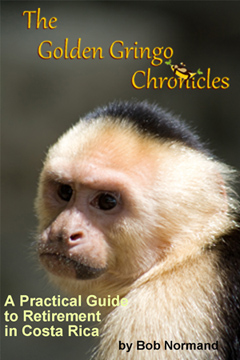 The story of the Golden Gringo Chronicles is also available as a hard copy novel of 192 pages available through Amazon and all major online retailers. ($9.95)
The story of the Golden Gringo Chronicles is also available as a hard copy novel of 192 pages available through Amazon and all major online retailers. ($9.95)
Amazon link: GGC, the Book. (Kindle Edition available)
Follow GG through the first six years of his odyssey in making the decision to retire in Costa Rica, overcoming the trials and tribulations of moving and obtaining residency there and the fun and experience of actually living in Ticoland.
Ride along with the Golden Gringo as he learns about the rich, varied culture of Costa Rica, the incredible bio diversity, the charming nature of the Costa Rican people and the ease with which a sometimes clueless ex-pat can assimilate into a small southwestern town on the Pacific coast.
Whether you are already a Costa Rican resident, someone contemplating a move here or just a traveler who enjoys different cultures, you will find the Golden Gringo Chronicles interesting, entertaining and informative about Costa Rica.
A narrative version of the Golden Gringo Chronicles is now also available as a trilogy of E-books in formats compatible with virtually all electronic platforms.
Part 1: (FREE!)
Leaving the Homeland
Part 2: ($3.99)
The Early Years
Part 3: ($3.99)
Becoming Tico, Maybe
Click on Part Number above for E-book sample downloads or click the price above right for purchase. (The best price is on Part 1; it's FREE)
Opt-In Here to Receive Your Free Copy Monthly
The Golden Gringo Chronicles is a free newsletter that is non-political, non-commercial and, hopefully, entertaining. By signing up you will receive an email each month around the first of the month giving you the links to the latest edition as well as to each individual feature and departmental section.
CLICK HERE TO SIGN-UP FOR THE
GOLDEN GRINGO CHRONICLES
or Email me at gg@goldengringo.com
Website: www.goldengringo.com

The Golden Gringo
Pura Vida!
To Contact GGC World Headquarters (yuk, yuk) to make comments, suggest topics or criticize my bad jokes, just send an email to: gg@goldengringo.com.
Be pithy but kind; I'm sensitive.
Unsubscribe from Golden Gringo Chronicles
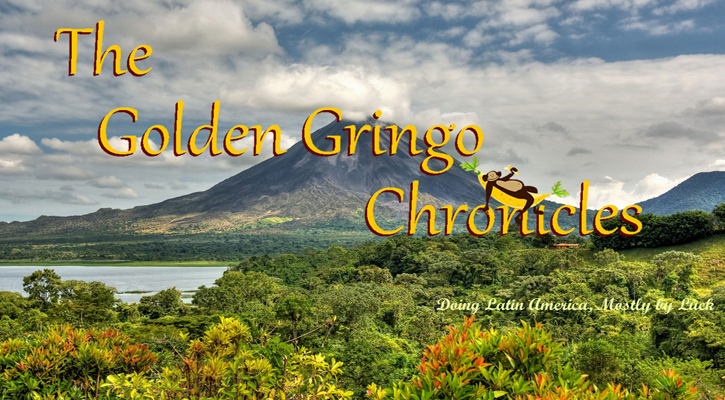

 Five hundred years before the Spanish found the American
continent, around the end of the first millennium, Native Americans lived and prospered in Central America, including the land now known as Costa Rica. Truly a natural wonderland then and now, the natives were able to employ their farming skills and prosper from the rich soils, the forests filled with game, herbs, and spices, and the lakes and two oceans rich with fish and crustaceans.
Five hundred years before the Spanish found the American
continent, around the end of the first millennium, Native Americans lived and prospered in Central America, including the land now known as Costa Rica. Truly a natural wonderland then and now, the natives were able to employ their farming skills and prosper from the rich soils, the forests filled with game, herbs, and spices, and the lakes and two oceans rich with fish and crustaceans.
 This year it began with a huelga on Monday the 8th, by the labor union representing the folks at ICE, the Instituto Costarricense de Electricidad, the power company. Often dressed colorfully (bright yellow is their trademark) , the march through town was rather uneventful, other than tying up traffic considerably in and about San José.
This year it began with a huelga on Monday the 8th, by the labor union representing the folks at ICE, the Instituto Costarricense de Electricidad, the power company. Often dressed colorfully (bright yellow is their trademark) , the march through town was rather uneventful, other than tying up traffic considerably in and about San José.


 GG's first encounter with a snook was on a plate in a restaurant in Sarasota when I moved there in 1998. It was grilled medium-firm white flesh that was served with a lemon butter sauce. Yummers!
GG's first encounter with a snook was on a plate in a restaurant in Sarasota when I moved there in 1998. It was grilled medium-firm white flesh that was served with a lemon butter sauce. Yummers! Fitting In. Some time ago GG came across an interesting Spanish verb. The verb "caber" means "to fit" or "to fit in". It just so happens that the first person singular for caber, i.e., if you were to say " I fit in", is "quepo" (there go those sneaky Spanish dudes changing verb stems again).
Fitting In. Some time ago GG came across an interesting Spanish verb. The verb "caber" means "to fit" or "to fit in". It just so happens that the first person singular for caber, i.e., if you were to say " I fit in", is "quepo" (there go those sneaky Spanish dudes changing verb stems again). Off the Rim of Fire. The main action in August was not on the Pacific Rim but instead in central Italy where a 6.2 quake hit in the Apennine mountains. Much like Costa Rica, Italy has a mountainous ridge running down its spine from north to south and the plates that formed these mountains continue to slip at an unpredictable pace.
Off the Rim of Fire. The main action in August was not on the Pacific Rim but instead in central Italy where a 6.2 quake hit in the Apennine mountains. Much like Costa Rica, Italy has a mountainous ridge running down its spine from north to south and the plates that formed these mountains continue to slip at an unpredictable pace.









 After living here a couple of years and then returning to the States, I once sipped a cup of java at a restaurant in Florida and almost lost my breadth. Where was the deep, rich flavor I had become used to? Not in this restaurant obviously. After sampling a number of places during that visit, I came to the conclusion, surprisingly and reluctantly, that the best coffee in that town was to be found at Starbucks. Really? Then I learned that Starbucks gets a fair portion of its beans from contract farms in Costa Rica. Fancy that.
After living here a couple of years and then returning to the States, I once sipped a cup of java at a restaurant in Florida and almost lost my breadth. Where was the deep, rich flavor I had become used to? Not in this restaurant obviously. After sampling a number of places during that visit, I came to the conclusion, surprisingly and reluctantly, that the best coffee in that town was to be found at Starbucks. Really? Then I learned that Starbucks gets a fair portion of its beans from contract farms in Costa Rica. Fancy that.
 Here's how the competition works: "Three cups are placed in a triangle, with 2 cups being identical coffees and one cup being a different coffee. Using skills of smell, taste, attention and experience, the cupper will identify the odd cup in the triangle as quickly as they can. A total of 8 triangles are placed in each round. The top 8 competitors with the most correct answers and the fastest time proceed to the Semi-Finals round. Then the top 4 will compete again in the Finals round to determine the next World Cup Tasters Champion."
Here's how the competition works: "Three cups are placed in a triangle, with 2 cups being identical coffees and one cup being a different coffee. Using skills of smell, taste, attention and experience, the cupper will identify the odd cup in the triangle as quickly as they can. A total of 8 triangles are placed in each round. The top 8 competitors with the most correct answers and the fastest time proceed to the Semi-Finals round. Then the top 4 will compete again in the Finals round to determine the next World Cup Tasters Champion."

 Take a short walk into almost any green area of Costa Rica (if it's the jungle, do so only with a guide) and you will most likely be set upon by a number of mariposas (butterflies) happily fluttering around you. The number and types of butterflies here are truly staggering; they are prolific and nearly omnipresent.
Take a short walk into almost any green area of Costa Rica (if it's the jungle, do so only with a guide) and you will most likely be set upon by a number of mariposas (butterflies) happily fluttering around you. The number and types of butterflies here are truly staggering; they are prolific and nearly omnipresent.













 Morphos can vary in the amount of brown trim on their wings and many have a completely brown underside. But the blue makes for their drama, particularly if you see them clustered by the dozens or even hundreds on the side of a tree as shown to the right. So what are they doing in those clusters anyway, just commiserating?
Morphos can vary in the amount of brown trim on their wings and many have a completely brown underside. But the blue makes for their drama, particularly if you see them clustered by the dozens or even hundreds on the side of a tree as shown to the right. So what are they doing in those clusters anyway, just commiserating? GG's Mariposa is a story that takes place around 1,000 AD, long before the Spanish arrived. The principal characters are two young Native Americans, each a favored child of a chief but of different tribes. The two tribes, historically hostile to each other, lived a few days march apart in the mountains north and east of Costa Rica’s central valley, within a few days marching distance of Volcan Turrialba.
GG's Mariposa is a story that takes place around 1,000 AD, long before the Spanish arrived. The principal characters are two young Native Americans, each a favored child of a chief but of different tribes. The two tribes, historically hostile to each other, lived a few days march apart in the mountains north and east of Costa Rica’s central valley, within a few days marching distance of Volcan Turrialba.











